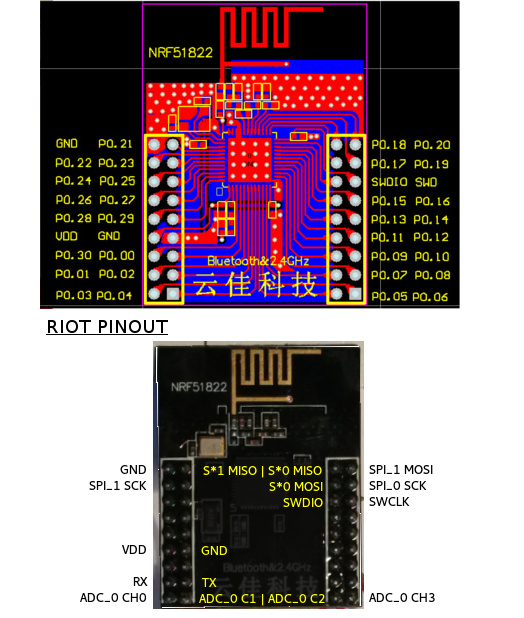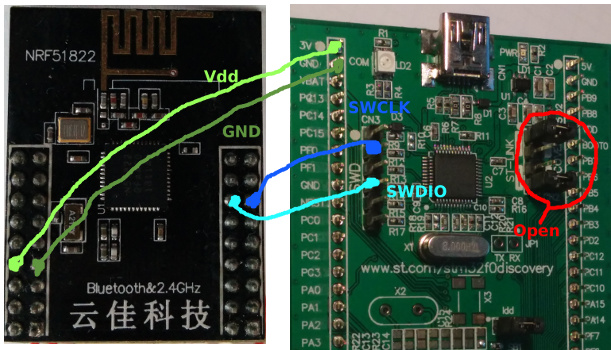mirror of
https://github.com/RIOT-OS/RIOT.git
synced 2025-01-15 10:52:43 +01:00
243 lines
8.3 KiB
Plaintext
243 lines
8.3 KiB
Plaintext
/**
|
|
@defgroup boards_yunjia-nrf51822 Yunjia NRF51822
|
|
@ingroup boards
|
|
@brief Support for the Yunjia NRF51822 board
|
|
|
|
## Overview
|
|
|
|
The NRF51822 module by Yunjia Technology is a minimalistic but very low-
|
|
priced module utilizing Nordics NRF51822QFAA SoC. The SoC features 16Kb of RAM,
|
|
256Kb of flash ROM and comes on top of the usual micro-controller peripherals
|
|
with a 2.4GHz radio that supports both Nordics proprietary ShockBurst as well as
|
|
Bluetooth Low Energy (BLE).
|
|
|
|
The board is available for example on [ebay](https://www.ebay.com/sch/i.html?_nkw=nrf51822)
|
|
or at [aliexpress](http://www.aliexpress.com/wholesale?SearchText=nrf51822&catId=0&initiative_id=SB_20140804233951) for something around 8-10 USD.
|
|
|
|
## Hardware
|
|
|
|

|
|
|
|
| MCU | NRF51822QFAA |
|
|
|:------------- |:--------------------- |
|
|
| Family | ARM Cortex-M0 |
|
|
| Vendor | Nordic Semiconductor |
|
|
| RAM | 16Kb |
|
|
| Flash | 256Kb |
|
|
| Frequency | 16MHz |
|
|
| FPU | no |
|
|
| Timers | 3 (2x 16-bit, 1x 32-bit [TIMER0]) |
|
|
| ADCs | 1x 10-bit (8 channels) |
|
|
| UARTs | 1 |
|
|
| SPIs | 2 |
|
|
| I2Cs | 2 |
|
|
| Vcc | 1.8V - 3.6V |
|
|
| Datasheet | [Datasheet](https://infocenter.nordicsemi.com/pdf/nRF51822_PS_v3.3.pdf) |
|
|
| Reference Manual | [Reference Manual](https://infocenter.nordicsemi.com/pdf/nRF51_RM_v3.0.1.pdf) |
|
|
|
|
|
|
## Flashing and Debugging
|
|
The Yunjia NRF51822 module comes without any on-board programming and
|
|
flashing capabilities. It supports however to be programmed using of-the-shelf
|
|
programmers as Segger's JLink or STM's STLink.
|
|
|
|
A very simple and affordable way to program and debug the Yunjia module is to
|
|
the integrated ST-Link/V2 programmer of any STM32Fx-discovery board. The needed
|
|
steps are described in the following sections. If you want to use a stand-alone
|
|
ST-Link adapter, you just simply have to alter the wiring to fit for your
|
|
programmer, the software part is identical.
|
|
|
|
### Hardware
|
|
First of all make sure the your ST-Link device is detected and can be
|
|
accessed properly. In Linux you might have to adept your `udev` rules
|
|
accordingly:
|
|
```
|
|
wget https://raw.githubusercontent.com/texane/stlink/master/etc/udev/rules.d/49-stlinkv2.rules
|
|
sudo cp 49-stlinkv2.rules /etc/udev/rules.d/
|
|
sudo udevadm control --reload-rules
|
|
sudo udevadm trigger
|
|
```
|
|
now replug the usb cable and flash.
|
|
|
|
Have a look at the 'Setting up udev rules' section in this
|
|
[README file](https://github.com/texane/stlink/)
|
|
if you need help.
|
|
|
|
Second you need to enable the stand-alone ST-Link mode of the discovery board
|
|
by removing the two `CN2` jumpers, found somewhere in the upper right part of
|
|
the board. This disconnects the ST-Link programmer from the micro-controller
|
|
part of the port and enables direct access through the pin-header `CN3`, also
|
|
labeled `SWD`.
|
|
|
|
The Yunjia NRF51822 module supports the Serial Wire Debug (SWD) interface. To
|
|
access the device the following four lines need to be connected with the
|
|
STM32x-discovery board:
|
|
```
|
|
Yunjia module STM32Fx-discovery
|
|
common ground: GND <-----------> GND
|
|
supply voltage: VDD <-----------> 3V
|
|
SWD clock: SWD <-----------> SWCLK (CN3, pin2)
|
|
SWD data I/O: SWDIO <-----------> SWDIO (CN3, pin4)
|
|
```
|
|
|
|
The following image shows the wiring for an STM32F0-discovery board (although
|
|
not the most beautiful...):
|
|
|
|

|
|
|
|
|
|
### Software
|
|
Debugging and programming the Yunjia module works well with [[OpenOCD]].
|
|
|
|
We suggest to use a fairly recent version, best use the upstream version from
|
|
their [git repository](http://sourceforge.net/p/openocd/code/ci/master/tree/).
|
|
Version 0.9.0-dev-00148-g3a4ec66 is reported to work.
|
|
|
|
### Programming the Device
|
|
To program the Yunjia NRF51822 module, just go to your RIOT application and
|
|
type:
|
|
```
|
|
make flash
|
|
```
|
|
and voila, the new firmware should be flashed onto your device.
|
|
|
|
### Resetting the Device
|
|
As the Yunjia module does not provide a reset button, RIOT includes a target
|
|
to reset the board. To do that, just type
|
|
```
|
|
make reset
|
|
```
|
|
and your board will reboot.
|
|
|
|
### Debugging the Device
|
|
The debugging setup comprises of two parts: a GDB server and a GDB client. To
|
|
usual workflow is to start the GDB server first and then connect to it with some
|
|
kind of front-end (e.g. command line, IDE, ...).
|
|
|
|
To start the GDB server, just type
|
|
```
|
|
make debug-server
|
|
```
|
|
This will start a local GDB server on `port 3333`.
|
|
|
|
If you are fine with working with the GDB command line client, you can start
|
|
debugging your device by just typing
|
|
```
|
|
make debug
|
|
```
|
|
in a second terminal window. This will automatically connect to your
|
|
previously opened GDB server and will also load your corresponding .elf file.
|
|
|
|
Alternatively you can configure your IDE (e.g. eclipse or similar) to connect
|
|
directly to the GDB server.
|
|
[See here for more information on how to configureEclipse](https://github.com/RIOT-OS/RIOT/wiki/Using-the-Eclipse-IDE-for-C-and-CPP-Developers,-Howto)
|
|
|
|
|
|
### Program the device manually
|
|
For OpenOCD to work correctly, you need the following configuration file
|
|
(which you can also find in `RIOTDIR/boards/yunjia-nrf51822/dist/openocd.cfg`:
|
|
|
|
```
|
|
$ cat RIOTDIR/boards/yunjia-nrf51822/openocd.cfg
|
|
# nRF51822 Target
|
|
source [find interface/stlink-v2.cfg]
|
|
|
|
transport select hla_swd
|
|
|
|
set WORKAREASIZE 0x4000
|
|
source [find target/nrf51.cfg]
|
|
|
|
# use hardware reset, connect under reset
|
|
#reset_config srst_only srst_nogate
|
|
```
|
|
|
|
You can now program your device by doing the following:
|
|
|
|
1. start openocd with: `openocd -d3 -f RIOTDIR/boards/yunjia-
|
|
nrf51822/dist/openocd.cfg`
|
|
2. open a new terminal an connect with telnet: `telnet 127.0.0.1 4444`
|
|
3. do the following steps to flash (only use bank #0 starting from address
|
|
0):
|
|
|
|
```
|
|
> flash banks
|
|
#0 : nrf51.flash (nrf51) at 0x00000000, size 0x00040000, buswidth 1,
|
|
chipwidth 1
|
|
#1 : nrf51.uicr (nrf51) at 0x10001000, size 0x000000fc, buswidth 1, chipwidth
|
|
1
|
|
|
|
> halt
|
|
target state: halted
|
|
target halted due to debug-request, current mode: Thread
|
|
xPSR: 0x61000000 pc: 0x00000e1a msp: 0x20001b2c
|
|
|
|
> flash write_image erase PATH-TO-YOUR-BINARY/YOUR-BINARY.bin 0
|
|
wrote xxx bytes from file PATH-TO-YOUR-BINARY/YOUR-BINARY.bin in xx.yys
|
|
(x.yyy KiB/s)
|
|
|
|
> reset
|
|
```
|
|
|
|
### Debugging manually
|
|
|
|
First you have to start OpenOCD as described in the section above.
|
|
|
|
Then enter the following in a new terminal:
|
|
|
|
```
|
|
$ arm-none-eabi-gdb -tui "<your binary ELF>"
|
|
|
|
(gdb) target remote localhost:3333
|
|
Remote debugging using localhost:3333
|
|
0x000119ce in ?? ()
|
|
|
|
(gdb) load
|
|
Loading section .text, size 0x2284 lma 0x16000
|
|
Loading section .ARM.exidx, size 0x8 lma 0x18284
|
|
Loading section .data, size 0x458 lma 0x1828c
|
|
Loading section .jcr, size 0x4 lma 0x186e4
|
|
Transfer rate: x KB/sec, xxxx bytes/write.
|
|
|
|
(gdb) monitor reset halt
|
|
target state: halted
|
|
target halted due to debug-request, current mode: Thread
|
|
xPSR: 0xc1000000 pc: 0x000006d0 msp: 0x000007c0
|
|
|
|
(gdb) break main
|
|
Breakpoint 3 at 0x123123: file ../main.c, line xx.
|
|
|
|
(gdb) continue
|
|
Continuing.
|
|
```
|
|
|
|
### Using UART
|
|
|
|
The UART pins are configured in [`boards/yunjia-nrf51822/include/periph_conf.h`](https://github.com/RIOT-OS/RIOT/blob/master/boards/yunjia-nrf51822/include/periph_conf.h).
|
|
The default values are PIN 1: `UART_RX` and Pin 2: `UART_TX` _(also compare
|
|
schematic above)_.
|
|
|
|
The BLE400 development board contains a CP2102 accessible through
|
|
/dev/tty.SLAB_USBtoUART. You have to edit periph_conf.h to use it with UART_RX
|
|
pin 11 and UART_TX pin 9.
|
|
|
|
The default Baud rate is `115 200`.
|
|
|
|
### Troubleshooting
|
|
#### Protected at factory (error writing to flash at address 0x000... )
|
|
|
|
This step may be executed before the first programming of the board. OpenOCD
|
|
provides the "nrf51 mass_erase" command to remove the protected flag on the
|
|
boot-loader region. RIOT does not use the proprietary Nordic "soft-device". This
|
|
is how to run the mass erase:
|
|
|
|
1. Open two terminal windows.
|
|
2. In one window, go to the RIOT root folder and run the regarding OpenOCD
|
|
configuration script with: `openocd -f boards/yunjia-nrf51822/dist/openocd.cfg`.
|
|
3. In the second terminal, connect to the device via telnet: `telnet
|
|
127.0.0.1 4444`.
|
|
4. If you are successfully connected via telnet, first type `halt` and then
|
|
`nrf51 mass_erase`.
|
|
|
|
This should have erased the whole memory of the device.
|
|
*/
|